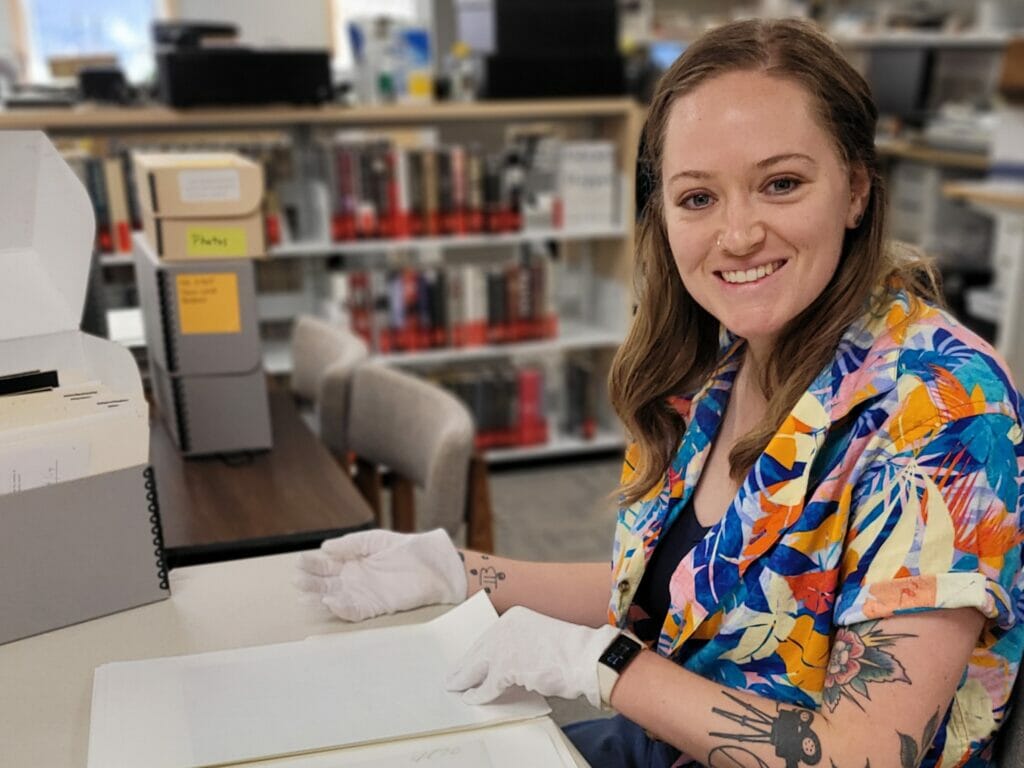By Kyla Merwin, Communications Manager
She sits in the Reading Room at The Community Library, all tattoos and curiosity. She pours through posters, magazine articles, and photographs in the Center for Regional History. She taps wildly at her laptop. She laughs at her own mad obsession with Idaho history.
This new creature in the archives is Skye Cranney, third generation Idahoan, gender historian, and doctoral candidate in American History at Southern Methodist University, Dallas, who hails from Meridian, Idaho.

I have to ask: What is a gender historian?
“I’m interested in the way gender has influenced and shaped aspects of American history,” states Skye. “I’m interested in questions of how masculine and feminine dynamics reach into everyone’s daily lives in ways they may not expect.”
Gender behaviors and expectations are so ingrained into our society, she explains, that we’re not even fully aware of them. “I want to pull those dynamics apart and understand why people of each gender do what they do.”
For example?
“My project is looking at how famous women behaved at Sun Valley starting in the 1930s, and how fan magazines were writing about them.”
“What caused that change? How does the fact that celebrity women were in Sun Valley, wearing and doing unprecedented things…How did that influence how the average American woman might change what she wears, how she recreates?”
Through the eyes of this earnest researcher, we can see a distinct change in acceptable ways that women could “recreate and play and be creative about it,” as Skye puts it. We can see how sports for women developed with Sun Valley publicity as a hinge pin.
“Take sportswear,” says Skye. “Today we see pants as an everyday thing. But women weren’t allowed to wear trousers for sports until the 1920s.
“What caused that change? How does the fact that celebrity women were in Sun Valley, wearing and doing unprecedented things…How did that influence how the average American woman might change what she wears, how she recreates?”
Images, artifacts, and memorabilia that Skye is finding in the Center for Regional History are “more helpful than I ever dreamed they would be.”
Take Ann Sothern, she notes. “Mary [Director of Regional History] showed me images of Ann at a party with Claudette Colbert and Norma Shearer. These women would not normally socialize together. Sun Valley brought them together, serving as a leveler, and building commonality that may not happened in Hollywood.”
“From the day I got here I was finding amazing stuff on women influencers from the 1930s; I was so excited. The collection here is extraordinary.”
Regional History Librarian, Kelley Moulton, and Mary have been diving into the archives to present Skye with unique resources. “There isn’t anything I found here that hasn’t helped my research,” says Skye, “including oral histories and many other things I didn’t know existed. I wasn’t expecting the resources to be so helpful, so fascinating.”
From Kelley’s point of view, the best part about working with researchers is the helping them find the unexpected. “This could be a random factoid I know but in a different context,” says Kelley. “And they come at it from a different lens, or something we stumble across together when looking at related materials. My job can feel a bit like a jigsaw puzzle at times because of that!”
Skye explains her lens on the Sun Valley vibe:
“From the beginning, Sun Valley was designed to pull in as many celebrities and as many luxuries as possible. Steve Hannagan [head of the Sun Valley marketing machine] had connections with famous people. His motto was that if you can’t do it right, don’t do it at all.”

Not even the weather can tarnish the glitz of Sun Valley.
“There was no snow on the resort’s opening day,” Skye explains, “so Steve brought in a bunch of Hollywood starlets to distract the crowds from the disappointing weather. Sun Valley soon became the height of luxury and glamor.
“But these women weren’t just sitting around being glamorous. They were really talented skiers. You can see that in the artifacts.
“From the day I got here I was finding amazing stuff on women influencers from the 1930s; I was so excited. The collection here is really understated.”
“It’s been such a cool experience being here.”
“Mary and Kelley have been extraordinarily helpful; they really listen to what I’m trying to find and they have such a knowledge of the collections, that, even when I’m vague, they’ve been able to present amazing things. They are so knowledgeable specific details about posters and memorabilia.”
Skye calls to mind Gretchen Fraser’s trading cards and her Wheaties cereal box. “Gretchen wasn’t famous when she came here. This woman athlete was getting a ton of attention from her Gold medal in the [1948] Olympics. She was the only woman in the Wheaties ad campaign that year.”
In contrast to the stars who made Sun Valley famous, Skye is intrigued how Gretchen–because she trained here–helped put Sun Valley on the Olympic map. She became a celebrity because of her Gold Medal and brought Sun Valley along for the ride.
“She’s opposite of the Hollywood people,” says Skye. Her trajectory is really interesting.”
As to Mary and Kelley, Skye gives all the kudos: “They’ve been so kind. Being able to work with them so closely has been a really neat experience and so helpful to the project. I’ve really enjoyed working with them.
“It’s been such a cool experience being here.”
